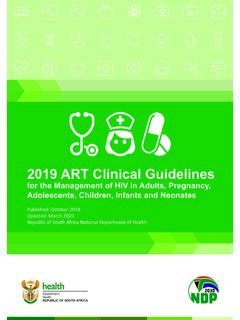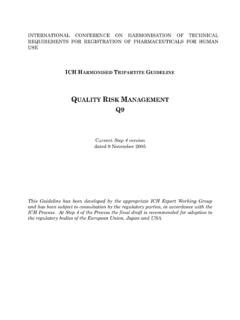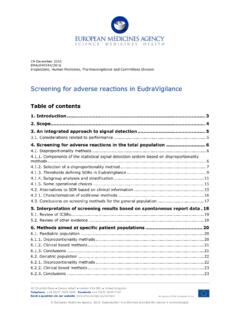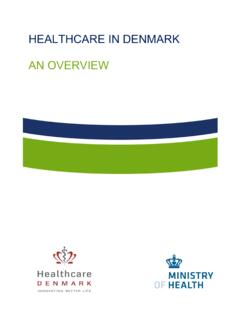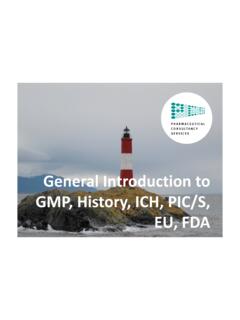Transcription of NATIONAL - Knowledge Hub
1 NATIONAL Published: February 2020 FOR THE MANAGEMENT OF HIV IN ADULTS, ADOLESCENTS, CHILDREN AND INFANTS AND PREVENTION OF MOTHER-TO-CHILD TRANSMISSION South African NATIONAL Department of HealthCONSOLIDATEDGUIDELINESBN ational Consolidated Guidelines iNational Consolidated Guidelines CONTENTList of Tables ..ivForeword ..vAbbreviations ..viiIntroduction ..ixBackground and Rationale ..ixTarget Audience ..xScope and Content ..xSection 1 The Minimum Package of HIV Prevention, Care and Treatment Services ..2 Section 2 HIV Testing Services and Linkage to Care ..10 HIV Testing Services ..10 Key guiding principles for HTS ..10 Consent for HTS in children ..10 The Basic Package of HTS services ..11 HTS approaches and settings: when, where, who, and what ..11 Frequency of Testing in Different Populations ..13 Types of tests to use in different age groups ..13 The HIV testing algorithm for all adults, adolescents, and children older than 2 years ..14 HIV Self Screening Algorithm.
2 14 HIV Index Testing Algorithm ..15 Linkage to Care ..18 Interventions to improve linkage to care ..18 Section 3 ART Initiation and Achieving Virological Suppression ..20 ART Eligibility ..20An overview of the ART initiation Initiation Step 1: Determine the timeframe for ART initiation ..20 Baseline Clinical Evaluation for Adults and Adolescents, Pregnant Women, and Children ..21 Baseline Laboratory Evaluation for Adults and Adolescents, Pregnant Women, and Children ..23 Assessing renal function ..24 Medical indications to defer ART ..25 ART Initiation Step 2: Determine if the client should be on first- or second-line ART ..26Re-initiating ART in Clients who have Interrupted Treatment ..26 ART Initiation Step 3: Choose the drugs in the regimen ..27 Overview of preferred ART regimens per age group ..27 Dolutegravir ..28 Dolutegravir Overview ..28 Drug Interactions with Dolutegravir ..29 Using DTG in women of childbearing potential ..30 Algorithm for recommending ART regimens in women and girls.
3 31 ART Initiation in Special Populations ..31 Dual Treatment of HIV and Active TB in Neonates, Infants, Children, Adolescents, and Adults ..32 ART Dosages, Substitutions, and Side-Effects ..33 ART Initiation Step 4: Interventions to support adherence to ART and retention in care ..33iiNational Consolidated Guidelines Key Adherence Messages ( NATIONAL Adherence Guideline) ..34 Managing a Client on ART ..35 Summary of the Care Continuum for Adult Clients on ART ..35 Summary of the Visit Frequency for Children and Adolescents Clients on ART ..36 Monitoring a Client on ART ..36 Principles of Viral Load Monitoring ..37 Assessing a Client with an elevated adults and adolescents who are on first-line NNRTI-based adult regimens to DTG-containing regimens (single drug substitution) ..40 Transitioning children and adolescents on first-line paediatric regimens to DTG-containing regimens (single drug substitution) ..41 Management of Viral Load Results in Infants, Children, Adolescents, and Adults.
4 42 Clients with a repeat VL of between 50 and 999 c/mL ..43 Second- and Third-line ART Regimens for Clients with Confirmed Virological Failure ..44 Resistance Testing ..45 Indications for resistance testing in adults and adolescents ..45 Indications for resistance testing in infants and children ..45 Third-line review committee ..45 Important considerations before doing a resistance test ..45 ART Side Effects ..46 Prevention, Screening, and Management of Common Co-infections and Co-morbidities ..49Co-trimoxazole Prophylaxis (CPT) ..49TB Preventive Therapy ..50 Tuberculosis (TB)..51 Cryptococcal Disease ..54 Management of Hepatitis B and C Coinfection ..55 Sexually Transmitted Infections (STIs) ..55 Cervical Cancer ..56 Management of Non-Communicable Disease and Other Conditions ..57 NATIONAL Pharmacovigilance Programme ..58 Section 4 PMTCT ..64 Overview of the Structure of Section 4 for Part One: Introduction and Overview of PMTCT of HIV ..65 PMTCT Part Two: Prevention ..66 Prevention of HIV.
5 66 Prevention of Unintended Pregnancies and Safe Conception in Women ..67 PMTCT Part Three: Charts per Service Delivery Clinic ..68 Labour and Delivery ..70 Care of The Mother after Birth ..72 Care of the HIV-Exposed Infant after Birth ..73 Care offered in the Community Setting ..74iiiNational Consolidated Guidelines PMTCT Part Four: Algorithms and Decision Tools ..75 ART Initiation in a Pregnant Women ..75 DTG-use in Pregnant and Breastfeeding Women ..76 Summary of First-line ART Regimens for Women of Childbearing Potential ..76CD4 Count and Toxicity Monitoring in the Pregnant or Breastfeeding Women ..77VL Monitoring in Pregnant and Breastfeeding Women ..77 Management of the Women with an Elevated VL ..79 The Pregnant Adolescent ..80 Prophylaxis for the HIV-Exposed Infant at Birth ..81 Principles for Infant Prophylaxis: ..81 Prophylaxis for the HIV-exposed Infant during Breastfeeding ..82 Summary of the Indications for High- and Low-risk Infant Prophylaxis ..82 Managing the Mother-Infant Pair with an Elevated VL after Delivery.
6 83 Breastfeeding ..84 Breastfeeding in a Women with an Elevated VL ..85 Stopping Breastfeeding ..85 Management of Indeterminate PCR Results and The Abandoned Infant ..86TB Screening and TPT During Pregnancy, Labour, and the Breastfeeding Period ..87 Management of the TB-Exposed Neonate ..88 Care of the HIV-Exposed but Uninfected Infant ..89 Syphilis ..90 Syphilis in Pregnancy ..91 Data Management in PMTCT ..92 Annexure 1 Summary of dosages, common side effects, and substitutions associated with first- and second-line ART in adults and adolescents ..93 Annexure 2 Antiretroviral Drug Dosing Chart for Children ..94 Annexure 3: Practical Advice on Administration of ART Medications ..95 Annexure 4: Initiating ART in HIV-infected neonates weighing kg at birth ..96 Annexure 5: ARV drug dosing chart for children from birth - 28 days of age with birth weight kg ( 35 weeks gestational age at birth) ..97 Annexure 6 Child and adolescent disclosure counseling for children living with HIV.
7 98 Annexure 7: Prophylactic Dosages for the HIV-Exposed Infant ..99 Annexure 8: Psychosocial support for pregnant and breastfeeding women ..100 Annexure 9: Third-line application form ..101 Annexure 10: Differentiated Models of Care (DMoC) Standard Operating Procedures ..102 Acknowledgements ..104 References ..105ivNational Consolidated Guidelines List of TablesTable 1 The minimum package of service to be provided at all facilities ..2 Table 2 An Overview of how HIV Testing approaches and settings can be adapted using a DSD approach ..12 Table 3 Frequency of testing in different populations ..13 Table 4 Types of HIV tests to use per age group ..14 Table 5 Interventions to Improve Linkage to Care ..18 Table 6 An overview of the ART initiation process using the DSD approach ..20 Table 7 Baseline Clinical Evaluation ..21 Table 8 Baseline Laboratory Evaluations ..23 Table 9 Assessing Renal Function ..24 Table 10 Medical Indications to Defer ART ..25 Table 11 Drug Interactions with DTG.
8 29 Table 12 The Risks and Benefits of DTG- and EFV-containing Regimens ..30 Table 13 Assessing an Elevated VL ..39 Table 14 Second-line ART Regimens for Adults ..44 Table 15 Second and Third-line ART Regimens for Children and Adolescents ..44 Table 16 Indications for Starting and Stopping CPT ..49 Table 17 CPT Dosing Chart ..50 Table 18 TPT per Category of Clients ..50 Table 19 Summary of First-line ART Regimens in Women of Childbearing Potential (WOCP) ..74 Table 20 CD4 and Toxicity Monitoring in the Pregnanct or Breastfeeding 21 Viral Load Monitoring in the Pregnant or Breastfeeding Woman ..75 Table 22 Prophylaxis for the HIV-Exposed Infant ..81 Table 23 Summary of the Indications for High-and Low-risk Infant Prophylaxis ..82vNational Consolidated Guidelines FOREWORDS outh Africa is committed to attaining the UNAIDS 90-90-90 targets to control the HIV epidemic through provision of quality health care services using highly effective antiretroviral treatment (ART). The principal goal of ART is to attain and maintain viral suppression, which will prevent new HIV infections, decrease morbidity and mortality as well as improve quality of life for clients.
9 All HIV positive pregnant and breastfeeding women, infants, children, adolescents and adults have been eligible for ART regardless of CD4 count or WHO staging since 01 September 2016. The Test and Treat All approach has made it possible for people living with HIV (PLHIV) to access ART NATIONAL Health Council (NHC) has adopted the new World Health Organization (WHO) recommended first- and second-line regimens that include Dolutegravir (DTG) as the preferred antiretroviral drug. The 2019 Consolidated Guidelines have been revised to include a new formulation of the fixed dose combination (FDC) of tenofovir (TDF) 300 mg + lamivudine (3TC) 300 mg + dolutegravir (DTG) 50 mg (TLD) for all eligible adults, adolescents and children 10 years and older and weighing 35 kg or more. These guidelines have further simplified ART provision and harmonized PMTCT and the management of children, adolescents and adults with HIV/AIDS, TB and other common opportunistic infections. The guidelines provide guidance for clinicians, managers and trainers on the use of available regimens within the context of the continuum of HIV comprehensive care for prevention, treatment and support for all age groups in private and public sector to realize our vision of A LONG AND HEALTHY LIFE FOR ALL.
10 Implementation of these guidelines will increase access to ART services, advance South Africa s ability to control the epidemic and help to achieve the 2030 SDG goals. I would like to thank all the internal and external stakeholders who actively contributed to the development of these is our sincere wish that all clinicians at PHC clinics, community health centres and hospitals across the board will use these guidelines to offer quality, comprehensive services to the Zweli MkhizeMinister of Health viNational Consolidated Guidelines ACKNOWLEDGEMENTSThe NATIONAL Department of Health would like to extend sincere appreciation to all who contributed to the development and finalization of this NATIONAL Consolidated Guidelines for the Management of HIV in Adults, Adolescents, Children, Infants and Prevention of Mother-to-Child Transmission. Special thanks to the health officials at NATIONAL , provincial and district levels, as well as development partners and civil society for their consistent support.

